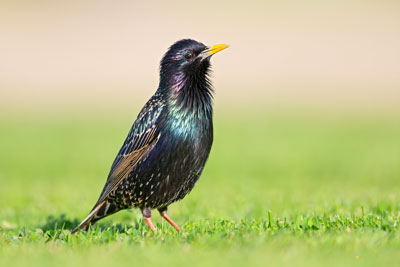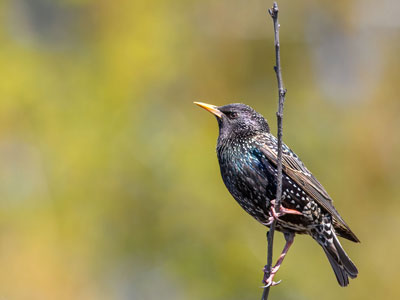




One hundred European starlings were brought to New York City's Central Park in 1890, and today there are hundreds of millions of them all across North America. Cities, towns, and urban areas are ideal habitats that have permitted starlings to expand.
Starlings out-compete many native birds, especially hole nesting birds, taking over cavity nests and birdhouses from other species. They also exploit any opening in buildings such as dryer, range and bathroom vents, and gaps around roofs and walls for nesting cavities. Starlings can also transfer many diseases between livestock animals, particularly swine. Starlings have been associated with histoplasmosis, chlamydiosis, salmonellosis and most recently West Nile virus. Around the home and yard, starlings consume a large number of insect pests; however, they can also damage fruit such as grapes, cherries, and raspberries and can tear open garbage bags.
Starlings consume and contaminate livestock feed and water, and whitewash buildings with their droppings. Large winter flocks of 2,000 starlings in Alberta are known to consume 1 to 2 tons of feed in a month and contaminate or spoil an additional 500 to 1,000 kilograms of feed. Starlings may also selectively eat the high-protein portion of protein-supplemented livestock feed.
Frightening or scare tactics are useful in driving starlings from roosting sites and fruit crops. Both visual and auditory frightening tactics have been effective. There are a number of noise-making devices and tape recorded distress or alarm calls being sold, in addition to gas-operated exploders, battery-operated alarms and lights. Visual devices such as mirrors, pie tins, mylar reflective tape, blinking or revolving lights, balloons, and colored flags or tapes have been effective when hung around areas to be protected. Good "old fashioned" human harassment or hazing, such as spraying with water, beating tin sheets or barrels, hollering, and throwing rocks or other things at roosting birds will discourage birds from using certain areas. For the best results, use a variety of techniques.
There are several repellents registered for use on starlings; however, some of these may be harmful to other birds that accumulate the material on their feet and feathers. Shoo Tacky Toes, Roost-No-More, 4-The-Birds, and Bird Tanglefoot are several of the nontoxic materials that have been useful in deterring starlings. These types of repellents are spread on roosting or perching ledges and rafters. These are non-toxic, soft, sticky materials that the birds do not like to get on their feet and feathers. Starlings need only 1 inch of space to roost or perch, so make sure you cover the area.
European starlings are not protected by federal or state law. Shooting may be an option to eliminate small numbers of birds and is probably more effective as a dispersal technique than a lethal solution. It is illegal and unsafe to discharge firearms within many cities, but it may be legal if done with air rifles or pellet guns. Check your local ordinances and decide if it would be not only legal but safe within your area.
Food-baited funnel, bob-type, or decoy traps are effective devices, allowing starlings to enter a trap but not exit. Decoy traps let birds enter continuously, building up the number of birds who call and attract even more birds. In addition, nest-box traps with spring loaded doors are commonly used to eliminate individual or small numbers of birds from an area. Instructions and patterns for making nest-box or decoy traps can be found at the Internet Center for Wildlife Damage Management Website.
Starlicide is a chemical compound commercially available as pelletized bait. The poisoned starlings are not dangerous to scavengers or predators. Directions for the use of starlicide must be followed closely. There are other poisons, pesticides, and even toxic perches available. Most of these require licensed applicators and/or government supervision to use. The use of any poisons is not recommended for general use and should be considered only as a last resort and for use only where large numbers of birds are to be removed.
European starlings are not protected by federal or state law. Shooting may be an option to eliminate small numbers of birds and is probably more effective as a dispersal technique than a lethal solution. It is illegal and unsafe to discharge firearms within many cities, but it may be legal if done with air rifles or pellet guns. Check your local ordinances and decide if it would be not only legal but safe within your area.
Exclusion is one of the best choices for homeowners. Evict starlings wherever they have gained entrance to your home or buildings and seal the entrance with hardware cloth or metal flashing. Light materials such as nylon or plastic netting and window screen will not keep out determined starlings as they can easily tear these materials out. Keep birdhouse openings to less than 1½ inches in diameter to exclude starlings. "Porcupine" wire, which has several parallel rows of 3-inch stiff wire attached, is also useful in deterring birds from roosting or nesting areas. Use netting to cover fruit trees and bushes.
